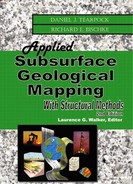Book Description
Applied Subsurface Geological Mapping, With Structural Methods, 2nd Edition is the practical, up-to-the-minute guide to the use of subsurface interpretation, mapping, and structural techniques in the search for oil and gas resources. Two of the industry's leading consultants present systematic coverage of the field's key principles and newest advances, offering guidance that is valuable for both exploration and development activities, as well as for "detailed" projects in maturely developed areas.
Fully updated and expanded, this edition combines extensive information from the published literature with significant material never before published. The authors introduce superior techniques for every major petroleum-related tectonic setting in the world.
Coverage includes:
A systematic, ten-step philosophy for subsurface interpretation and mapping
The latest computer-based contouring concepts and applications
Advanced manual and computer-based log correlation
Integration of geophysical data into subsurface interpretations and mapping
Cross-section construction: structural, stratigraphic, and problem-solving
Interpretation and generation of valid fault, structure, and isochore maps
New coverage of 3D seismic interpretation, from project setup through documentation
Compressional and extensional structures: balancing and interpretation
In-depth new coverage of strike-slip faulting and related structures
Growth and correlation consistency techniques: expansion indices, Multiple Bischke Plot Analysis, vertical separation versus depth, and more
Numerous field examples from around the world
Whatever your role in the adventure of finding and developing oil or gas resources–as a geologist, geophysicist, engineer, technologist, manager or investor–the tools presented in this book can make you significantly more effective in your daily technical or decision-oriented activities.
Table of Contents
- Copyright
- Foreword
- Preface
- Acknowledgments
- Daniel J. Tearpock (Subsurface Consultants & Associates, LLC.)
- Richard E. Bischke (Subsurface Consultants & Associates, LLC.)
- 1. Introduction to Subsurface Mapping
- 2. Contouring and Contouring Techniques
- 3. Directionally Drilled Wells and Directional Surveys
- 4. Log Correlation Techniques
- Introduction
- Electric Log Correlation Procedures and Guidelines
- Correlation Type Log
- Electric Log Correlation – Vertical Wells
- Electric Log Correlation – Directionally Drilled Wells
- Electric Log Correlation – Horizontal Wells
- Computer-Based Log Correlation
- Repeated Section
- Estimating Restored Tops
- Unconformities
- Annotation and Documentation
- 5. Integration of Geophysical Data in Subsurface Mapping
- 6. Cross Sections
- Introduction
- Planning a Cross Section
- Structural Cross Sections
- Stratigraphic Cross Sections
- Problem-Solving Cross Sections
- Finished Illustration (Show) Cross Sections
- Correlation Sections
- Cross Section Design
- Vertical Exaggeration
- Projection of Wells
- Cross Section Construction Across Faults
- Three-Dimensional Views
- Cross Section Construction Using a Computer
- Fault Seal Analysis
- 7. Fault Maps
- Introduction
- Fault Terminology
- Definition of Fault Displacement
- Mathematical Relationship of Throw to Vertical Separation
- Fault Data Determined From Well Logs
- Fault Surface Map Construction
- Types of Fault Patterns
- Fault Data Determined From Seismic Information
- Growth Faults
- Directional Surveys and Fault Surface Maps
- Vertical Separation – Correction Factor and Documentation
- 8. Structure Maps
- Introduction
- Guidelines to Contouring
- Summary of the Methods of Contouring by Hand
- Contouring Faulted Surfaces
- Manual Integration of Fault and Structure Maps
- Fault Traces and Gaps – Shortcuts and Pitfalls
- Structure Map – Generic Case Study
- The Additive Property of Faults
- Integration of Seismic and Well Data for Structure Mapping
- Other Mapping Techniques
- Application of Contour Compatibility Across Faults
- Mapping Techniques for Various Tectonic Habitats
- Requirements for a Reasonable Structural Interpretation and Completed Maps
- 9. Interpretation of Three-Dimensional Seismic Data
- 10. Compressional Structures: Balancing and Interpretation
- 11. Extensional Structures: Balancing and Interpretation
- Introduction
- Origin of Hanging Wall (Rollover) Anticlines
- A Graphical Dip Domain Technique for Projecting Large Growth Faults to Depth
- Origin of Synthetic and Antithetic Faults, Keystone Structures, and Downward Dying Growth Faults
- Three-Dimensional Effects and Cross Structures
- Strike-Ramp Pitfall
- Compaction Effects Along Growth Normal Faults
- 12. Strike-Slip Faults and Associated Structures
- 13. Growth Structures
- 14. Isochore and Isopach Maps
- Introduction
- Sand–Shale Distribution
- Basic Construction of Isochore Maps
- Methods of Contouring the Hydrocarbon Wedge
- Vertical Thickness Determinations
- Vertical Thickness and Fluid Contacts in Deviated Wells
- Mapping the Top of Structure Versus the Top of Porosity
- Fault Wedges
- Nonsealing Faults
- Volumetric Configuration of a Reservoir
- Reservoir Volume Determinations From Isochore Maps
- Introductory Reservoir Engineering
- Interval Isopach Maps
- Appendix
- References
